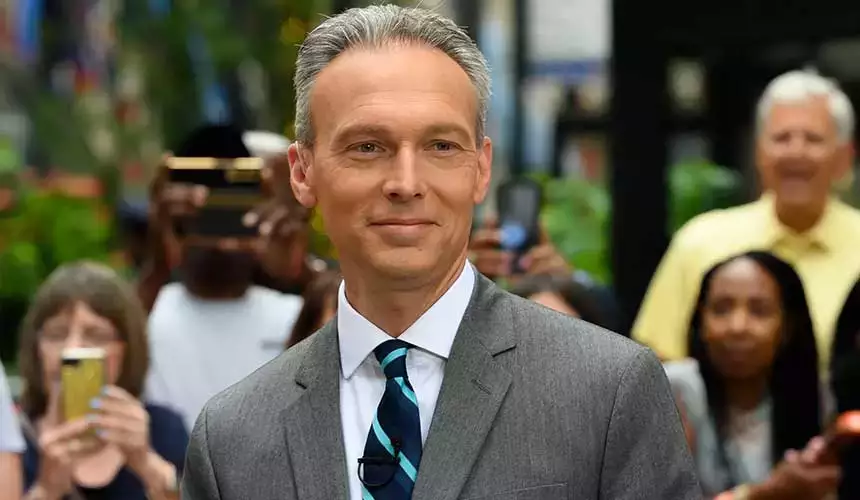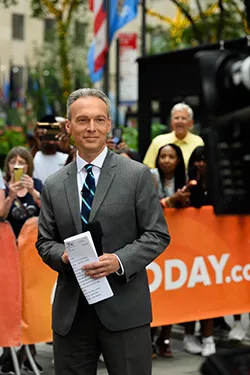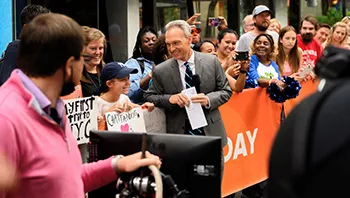
Twenty-five years ago, SUNY Oneonta alumnus Bill Karins made his first television appearance on the university’s weekly, student-run “Red Dragon News” program. Today, you can see him in action any day of the week by turning the channel to NBC News, MSNBC or NBC News Now, where you’ll find him reporting on the nation’s weather as the chief meteorologist for MSNBC.
Advice for Oneonta Students
Network and take advantage of every resource and connection you make. “People are willing to help much more than anyone realizes – they feel good about doing it and like giving back,” Karins said. “But you have to ask. Lots of times, you think you’re not important enough or are afraid of being rejected. But you have to just be aggressive, ask questions and ask for help. Ask for opportunities, and you’ll be rewarded.”
“That’s the best thing about my job,” Karins said. “When you’re a local meteorologist, you only get to cover local stories. But I get to cover every big weather story in the country. It’s a weather person’s dream come true.”
A Day in the Life
Each morning, Karins’ alarm clock goes off at 3 a.m. From 5 a.m. on, he’s in front of the camera educating – and sometimes warning – the nation. On slow days, Karins gets to cover important topics and broad stories such as droughts or climate change. For a while, he was a regular on NBC’s Saturday “Today Show” and he still occasionally fills in for his colleague, anchorman Al Roker.
If there’s an especially big weather event to report, Karins doesn’t see his family for days on end. After more than two decades in the business, he still gets a pit in his stomach before a dangerous storm hits.
“Not because I’m nervous to be on camera,” he explained, “but because, let’s say I know that a big tornado is about to touch down. I get a sinking feeling knowing that the houses in its path will likely be destroyed.”
Putting in the Time
After graduating from SUNY Oneonta with a Meteorology degree in 1996, Karins applied for jobs at 27 different TV stations across the country and got one call back from a station in Topeka, Kansas, a state in which he had “never stepped foot.” That first gig paid just $16,000.
After a year in Kansas, Karins was hired at a station in North Carolina and, later, Maine, where he became chief meteorologist at the age of 25. That’s when he got his big break, landing a job in Orlando. This position opened the door for him to move to New York and work for NBC, where he’s been for 17 years.
“In Kansas, we’d chase tornados,” he recalled. “In Orlando, we had three hurricanes hit in six weeks. And in Maine, I saw 120 inches (10 feet!) of snow one winter. I’ve been very fortunate to experience all of this firsthand. Looking back, each one of my jobs taught me patience and that you have to put in the time and sacrifice for a while before you get to reap the rewards.”
Karins’ first time on national television was in front of millions on NBC Nightly News, just as Hurricane Katrina was about to make landfall in Florida in August 2005. Karins forecasted that the tropical cyclone would hit Miami and that there was a chance it could head toward New Orleans and get much stronger. Many NOLA residents were evacuated before the hurricane struck. Just days after Karins’ prediction, the Category 5 storm had breached levees and caused widespread destruction, going down as the third deadliest hurricane in U.S. history.
“That was the moment I got my reputation at NBC and started to gain trust,” Karins said. “You never know for sure the impact you had, but you have some inclination. People think of this job as being just about entertainment, but in the end, it’s about saving property and lives and helping people, and that’s what I really love.”
The Red Dragon Family
While at Oneonta, Karins spent a great deal of time with the Earth and Atmospheric Sciences Department, which was “small, but like a family.” He vividly remembers taking part in Dr. Jerome Blechman’s forecasting contests, walking through the snow to classes, and participating in Earth Science Night at College Camp, where he would frequently hike and walk. He was also on the baseball team and a member of the Beta Chi fraternity.
“I was a good student, but I was always talking,” Karins recalled with a laugh. That’s when he discovered his talent at communicating and began to hone these skills with help from Oneonta’s Communication Department, which was fairly new but growing quickly.
“At that time, we had to be creative with not a lot of resources,” he said. “In those types of situations, you learn what makes you marketable, as well. For instance, there are a lot of good TV anchors and a lot of good meteorologists, but it’s the combination of the two – good communicating and forecasting – that has helped me get to where I am today.”



